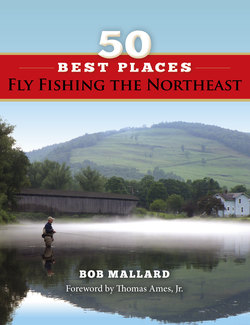Читать книгу 50 Best Places Fly Fishing the Northeast - Bob Mallard - Страница 27
На сайте Литреса книга снята с продажи.
Оглавление2 . Maine Brook Trout Ponds
Location: Western, Central, and Northern Maine, about a 2- to 3-hour ride from Bangor, a 3- to 4-hour ride from Portland; and a 4- to 5-hour ride from Boston, Massachusetts or Manchester, New Hampshire. Full-service airports are available in all four cities. Float plane pickup from lakes within an hour of Bangor can be arranged.
Maine boasts one of the largest (if not the largest) inventories of pond-dwelling, self-sustaining native trout populations in the continental United States—in this case Eastern brook trout. There are more than 600 such waters scattered across the state. Roughly 325 have never been stocked. The rest have not been stocked in at least 25 years. This represents approximately 95 percent of the remaining self-sustaining native brook trout lakes and ponds in the country.
There are another 500 or so ponds in Maine that are stocked with brook trout. Many of these support strong populations of holdover fish. This brings the total number of brook trout ponds in Maine to roughly 1,100—far more than are found anywhere else in the country.
Approximately 175 of the brook trout ponds in Maine are classified as Remote by the Land Use Planning Commission. This means that there is no development—including permanent roads—within a half mile of the shoreline. In most cases, even unimproved roads have been blocked. These represent some of the most pristine brook trout ponds in the Northeast.
It would be impossible—and I believe a real disservice—to try to name just one of these ponds for the purposes of this book. In aggregate, they represent a fly-fishing resource unlike anything else found in the Northeast. In fact, they probably bring more anglers to Maine than all the rivers and streams put together. As a result, I have opted to cover them as a group.
The majority of Maine’s best brook trout lakes and ponds are found in the western, central, and northern parts of the state. They are located off a network of unmarked, and often unmaintained, dirt roads. While many of these are located on private land managed for forestry, others are on public land such as sprawling Baxter State Park, private land owned by individuals such as philanthropist Roxanne Quimby, private land owned by conservation groups such as The Nature Conservancy, and conservation easements managed by groups such as the Appalachian Mountain Club.
Under Maine’s Great Ponds Act, all lakes and ponds over 10 acres are open to the public for the purpose of fishing. This law guarantees overland access solely for fishing—all other activities fall under the standard laws governing trespass. This does not allow for vehicular access, or even unobstructed foot access. Landowners can—and do—gate their property wherever they see fit, often requiring a long walk to reach the water.
Bob Mallard hooked up on a remote pond. Thomas Ames, Jr.
Most of Maine’s best brook trout lakes and ponds are located outside the power grid. Gas, food, lodging, and services are often in short supply. While this presents a certain logistical problem for the visiting fly fisherman, many of these waters are near traditional sporting camps that offer lodging, meals, guides, rental boats, and even float plane service. This is often the most convenient, and safest, way to take advantage of this wonderful resource.
Fishing Maine’s brook trout lakes and ponds effectively requires some type of watercraft. Shorelines are lined with trees, and the bottoms are usually muddy, making wade fishing all but impossible. Float tubes, canoes, and small rowboats are often used. Some of the larger waters have boat launches. In many cases, it is the distance from the road that dictates what type of watercraft is needed. On many of the more remote waters, sporting camps maintain an inventory of rental boats.
